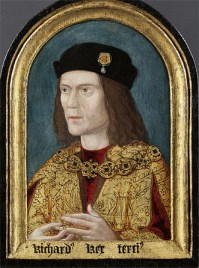
King Richard III
It’s been a remarkable six month or so journey. Who would have believed that when archaeologists from the University of Leicester began digging up a municipal car park in the the city in August 2012 – on the supposedly wild goose chase to find the remains of the last Plantagenet king, Richard III – that they would have been so incredibly successful. And in such a short time.
I’ve been fascinated by the unfolding story of the dig, and the extraordinary ‘appliance of science’ to arrive at irrefutable conclusions. From all appearances, the project has demonstrated remarkable teamwork among staff at the university (primarily the Departments of Archaeology & Ancient History and Genetics) and the King Richard III Society. And the team reached out to other experts to fill in the gaps, so to speak.
Last week there was a fascinating TV program that filled in some of the details about how the discovery of the skeleton came about, and how the people involved went about to confirm its identity.
Of course, one has to pay credit to Philippa Langley of the King Richard III Society who seems to have been the driving force behind the whole project – and believed! But the project also seems to be a good example of ‘the perfect storm’ – so many things came together at the same time.
It was long believed that King Richard had been buried in Leicester, probably at the Greyfriars Friary that disappeared after the Reformation in the sixteenth century. But where to begin to look in a city that had been paved over for centuries.
Piece of luck, number 1. It seems there is still a good coincidence between today’s streets and those of medieval times. Overlaying maps, the team was able to focus in on a part of the city that is still known as Greyfriars, in fact to a municipal car park. And the archaeology team opened three trenches. Almost immediately they uncovered human remains. But were they the remains of King Richard III? That’s where the appliance of science came to the fore. However, as one of the archaeology team pointed out, opening a trench just 50 cm to one side or the other and they would have missed the skeleton altogether.
So what was the evidence that this really was King Richard III?
- The skeleton appeared to have been buried in haste, possibly with wrists bound together, and showing considerable trauma such as fatal blows to the skull.
- The spine showed severe twisting or scoliosis which Richard was known to suffer from, although there was no evidence of a withered left arm (another piece of Tudor propaganda?).
- On closer analysis, however, there were features of the skeleton which suggested that it might be female (subsequently disproved), such as shape of the pelvis and slender forearms. Apparently Richard was reported, even in his own lifetime, to be somewhat ‘slender’.
- Careful CT scans were made of the skeleton before cleaning, and 3D images of the skull were used by Professor Caroline Wilkinson, Professor of Craniofacial Identification at the University of Dundee to attempt a facial reconstruction (that was revealed after the skeleton’s identity was confirmed as that of Richard III).
- Carbon dating evidence was rather interesting. From unadjusted data it appeared that the person had died some decades before Richard did at the Battle of Bosworth in August 1485. However, it seems that this person had a diet rich in fish and seafood (a sign of affluence) and this made the skeleton appear older than it was. An adjusted date covered the 1485 period.
-
Then there’s the genealogical data. Some years earlier, direct descendants of Richard III’s elder sister, Anne of York, had been traced (over 18 generations). In fact several descendants have been traced, but some wish to remain anonymous. One was a Canadian cabinet maker living in London, who is the great, great, great . . . nephew of Richard III. And this leads on to the most exciting aspect – the DNA analysis.
- Genetic fingerprinting was ‘invented’ at the University of Leicester by Professor Sir Alec Jeffreys FRS in the 1980s. And it turns out that there are several lines of research in the Department of Genetics at Leicester studying lines of descent and their correlation with surnames. Using mitochondrial DNA (mtDNA), which is inherited only through the female side, geneticist Dr Turi King was able to show unequivocally that there was a perfect match between the mtDNA of the skeleton and our Canadian cabinet maker, thus proving that the skeleton was indeed that of King Richard III. Perfect matches were also made with another descendant of Anne of York, and the skeleton was confirmed as ‘male’ through analysis of Y chromosome DNA.
So many different strands of interest and expertise came together in this exciting project, and all at the right time. The team has to be congratulated for all their efforts – it really has been a most exciting story to follow. Now let’s see where they do finally decide to re-bury the king: Leicester or York (which is lobbying hard). I think Leicester will win out.
Update (18 March 2015)
Well, Leicester has ‘won’ if that’s the correct description, and the remains of Richard III will be interred next week – with all appropriate honour – in Leicester Cathedral. And rightly so. The hoo-ha of where he should be buried has certainly demeaned this incredible project.
Anyway, to cut a long story short, as I was surfing through the web pages of The Guardian earlier this morning, I came across a link where you can find much more information about the whole Richard III project since I first wrote this particular blog post just two years ago.
